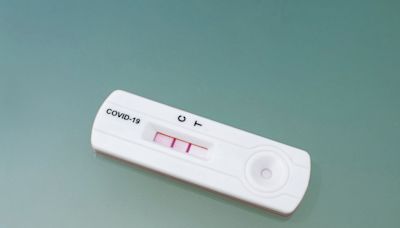Ad
related to: how high is fever with coronavirus cdcThe Latest COVID-19 Facts, News & Possible Answers To Frequently Asked Questions. Updated Coronavirus Information About Recommendations, Resources, And Latest Studies.
Search results
Mar 15, 2024 · New guidance from the CDC advises people to isolate until they have been fever-free and with symptoms improving for at least 24 hours, and then take precautions for five days, which covers the...
- Overview
- Temperature range
- Other things to know about fever and COVID-19
- Other symptoms of COVID-19
- When to seek care
- The bottom line
A fever is when your body temperature is 100.4°F (38°C) or greater. See a doctor if temperatures are at least 100.4°F (38°C) for infants, 102.2°F (39°C) for children, and 103°F (39.4 C) for adults.
COVID-19 symptoms, including fever, can start anywhere from 2 days to 2 weeks after exposure to the virus.
Fever is one of the ways your body tries to fight off infection. For that reason, it’s a common symptom of COVID-19, which typically gets reported by those who have it.
However, not everyone who gets COVID-19 will develop a fever.
According to the CDC, you have a fever if your temperature is 100.4°F (38°C) or greater, no matter what the cause.
Read on to find out about fever as a symptom of COVID-19 and other symptoms that require medical care.
In addition to being new, COVID-19 has often been unpredictable. As common a symptom as fever is, there is no definitive temperature range for this condition. Some people who test positive never run a fever. Others spike very high fevers.
A large review of multiple studies across nine countries observed 24,420 adults with COVID-19, and 78 percent ran a fever at some point during their illness.
A later review of studies involving 17,515 adults and children with COVID-19 uncovered similar results. Of all the adult participants, 79.43 percent ran a fever during their illness. Low- and medium-grade fevers were also more likely to occur in this population than high fevers.
Researchers also noted that fever was less likely to occur in children, especially during the early days when symptoms begin. They found that 45.86 percent of 373 children in China experienced fever. The authors conclude that over 50 percent of children under 18 years old with COVID-19 presented without fever.
Despite the lack of a specific temperature range, it is clear that fever can indicate serious illness. The majority of hospitalized COVID-19 patients have fever as a symptom. However, running a high fever does not mean you will have a serious outcome.
A study involving over 7,000 COVID-19 patients in the New York City area found that initial high fever upon hospital admission did not correlate significantly with death.
However, persistent high fevers throughout the course of illness were significantly correlated with death due to COVID-19. People whose fevers spiked to 104°F (40°C) or higher had a mortality rate of 42 percent.
This same study found that abnormally low body temperatures were associated with the poorest outcomes. Those with a body temperature under 96.8°F (36°C) had the highest death rates.
COVID-19 may present with one or more of these symptoms:
•cough, this is the second most common symptom after fever
•chills
•loss of taste or smell
•difficulty breathing or shortness of breath
•exhaustion or fatigue
Fever can be an indication of many illnesses, not just COVID-19. However, if you have any COVID-19 symptoms and may have been exposed to the virus, speak with a health professional immediately. There are medications and treatments that can help reduce the possibility of serious disease.
If you run a temperature of 100.4°F (38°C) or greater, get tested. Early testing can help ensure better outcomes.
No matter what the possible cause, high fevers such as these should always prompt a call to a health professional:
•Infants: rectal temperature of 100.4°F (38°C) or higher.
•Toddlers and children: temperature over 102.2°F (39°C).
•Adults: temperature of 103°F (39.4 C) or higher — potentially a sign of serious COVID-19 disease.
COVID-19 does not have a temperature range associated with it. People with COVID may spike high fevers or have no fever at all. Very high fever is associated with higher mortality rates among people with COVID-19. Too-low body temperature can also be indication of serious COVID-19 disease.
- Corey Whelan
Mar 1, 2024 · Press Release. For Immediate Release: Friday, March 1, 2024. Contact: Media Relations. (404) 639-3286. CDC released today updated recommendations for how people can protect themselves and their communities from respiratory viruses, including COVID-19.
Mar 1, 2024 · When, for at least 24 hours, your symptoms are getting better overall and you have not had a fever (and are not using fever-reducing medication), you are typically less contagious, but it still takes more time for your body to fully get rid of the virus.
Mar 15, 2024 · Updated Mar. 15, 2024. Español. Print. People with COVID-19 have reported a wide range of symptoms ranging from mild symptoms to severe illness. Symptoms may appear 2-14 days after exposure to the virus. Anyone can have mild to severe symptoms. Possible symptoms include: Fever or chills. Cough. Shortness of breath or difficulty breathing. Fatigue.
Oct 13, 2022 · Q: What is considered a fever for COVID-19? A: A temperature higher than 38°C (100.4°F) is considered to be a fever. Q: When to go to the hospital for COVID-19 fever? A: If your fever doesn’t go away or if you’re experiencing emergency warning signs of COVID-19, then you should go to the hospital.
Mar 5, 2024 · If symptoms or fever return, you should start back at square one: staying home and away from others until you’ve been improving and fever-free for at least 24 hours. What should you do if you’re at higher risk of severe illness?


